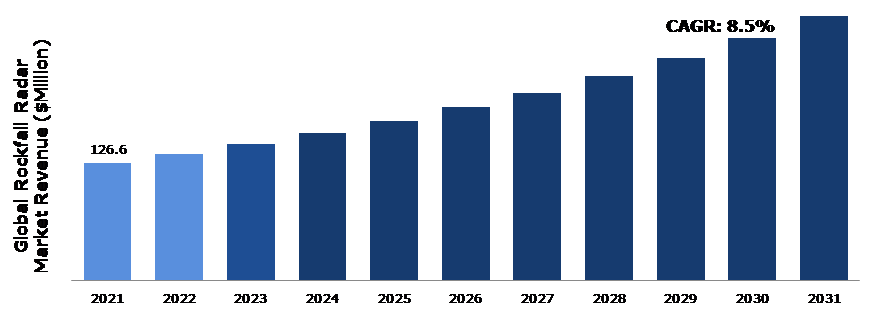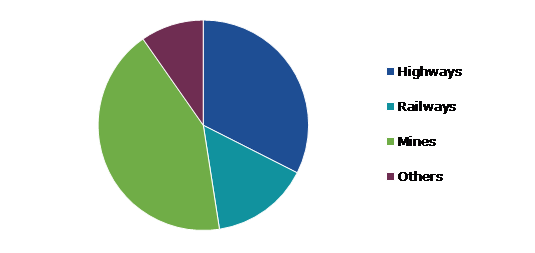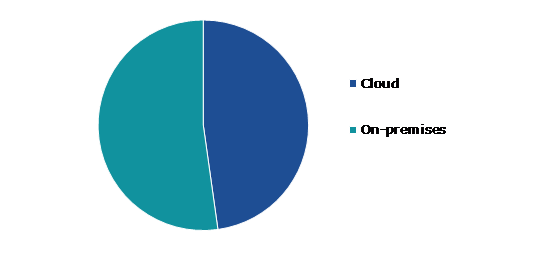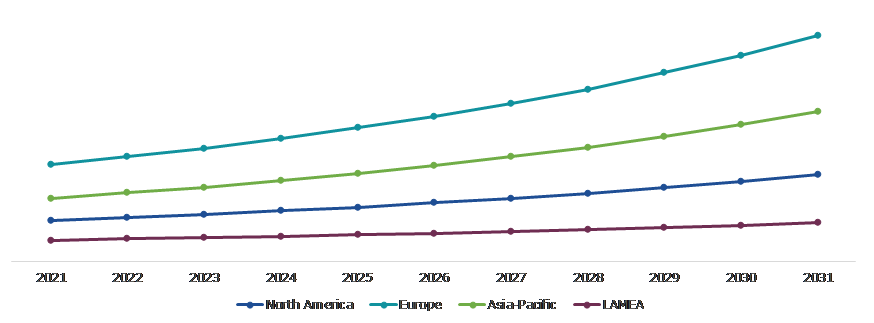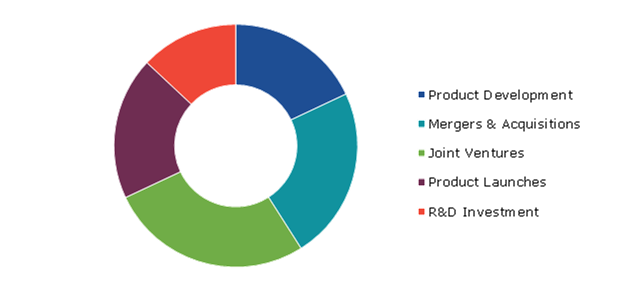Rockfall Radar Market Report
RA08606
Rockfall Radar Market by Application (Highways, Railways, Mines, and Others), Offering (Cloud and On-premises), and Regional Analysis (North America, Europe, Asia-Pacific, and LAMEA): Global Opportunity Analysis and Industry Forecast, 2022–2031
Global Rockfall Radar Market Analysis
The Global Rockfall Radar Market Size was $126.6 million in 2021 and is predicted to grow with a CAGR of 8.5%, by generating a revenue of $285.6 million by 2031.
Global Rockfall Radar Market Synopsis
The increasing demand for rockfall radars is majorly attributed to the rising rockfall events in the mines and on the highways. Rockfall events are a crucial safety threat to the mining sector. Rockfall radars can locate and track the rockfall and landslide events in real-time and provide important event-related statistics to geotechnical engineers. Rockfalls, landslides, and debris flow represent major security dangers for the transportation routes and operation of the mining sector. The effectiveness of the traditional rockfall monitoring techniques is not satisfactory. This in turn is anticipated to expand the demand for rockfall radars during the forecast period.
The high cost of investment, however, may hinder the overall rockfall radar market growth during the forecast timeframe. In addition, the lack of skilled personnel along with less awareness about rockfall radars in developing nations is likely to limit the rockfall radar market expansion.
Rockfall radar can be used on railway lines and in tunnels. In mountainous territories landslides, rockfall, and debris flow events frequently occur. Additionally, coastal areas and alpine valleys with a high number of transportation corridors, tourism points, and high population density have more chances of rockfall disasters. Such disasters often cause huge economic losses as well as casualties and jeopardize the safety of civil tunnels and railway lines. While constructing tunnels extensive present and future study of rockfall risk is important and proper security measures are essential. Moreover, risk analysis is also required to evaluate the effects of expected rockfall disasters. These factors are likely to offer excellent growth opportunities to the rockfall radar market share during the forecast period.
According to regional analysis, the Europe rockfall radar market accounted for the highest market share in 2021 and is projected to maintain its dominance over the forecast period. Europe region is most affected by landslides across the world. In the last few years, a significant rise in the number of rockfalls has been observed on the Alpine arc. In addition, permafrost temperatures are also increasing in the alps. This may likely increase the number of slope instabilities in the upcoming years.
Rockfall Radar Market Overview
Rockfall radar is a radar-based system for detecting and tracking rockfall events on highways, railways, in the mines, etc. Rockfall disasters could result in fatal injuries to people as well as cause severe damage to buildings and infrastructure. Rockfall radar helps in detecting the possibility of rockfalls in real-time and in any weather. It can be integrated with tablet and smartphone and can be installed easily. Rockfall radars can work in all weather such as snowfall, rain, etc. In addition, they offer wide-area coverage for tracking and mapping of rockfall prone sites.
COVID-19 Impact on Rockfall Radar Market
The COVID-19 outbreak has negatively impacted the rockfall radar market growth. Stringent lockdowns as well as business shutdowns impeded manufacturing operations and transportation activities, which severely disrupted the supply chains. Rockfall radar generally has high demands from mines and highway operators. During the pandemic, the transportation sector was among those that experienced the most significant impacts, especially in the case of roads and highways. Rockfall causes severe danger in rock-cuts roads in mountainous areas giving rise to a large amount of damage as well as casualties. However, during the pandemic, the levels of traffic reduced dramatically across the world, which in turn reduced the need for operation and maintenance activities. In addition, COVID-19 led to a slowdown in construction investment activities. These aforementioned factors severely impacted the growth prospects of the rockfall radar market revenue.
Rockfall radar is one of the most important technological advancements that aid in reducing the danger of rockfalls in mines. Efficient controlling of rockfall-related dangers is needed for safe operations and most of such threats are mitigated through cutting-edge technologies such as rockfall radars. However, the mining industry was severely impacted during the pandemic on account of various strict measures set by governments to curb the spread of COVID-19. This in turn, negatively affected the business prospects of the rockfall radar industry growth.
Increased Number of Rockfall Disasters Worldwide to Drive the Rockfall Radar Market Growth
Rockfalls are often caused by biological or climatic events such as heavy rainstorms, infiltration, cold climates, chemical degradation, root growth, etc. Such events often result in a change in the forces acting on a rock. Rockfall events are one of the most common hazards on the rock-cut highways and railways in the mountainous region. A substantial number of casualties across the world occur every year due to rockfalls. Rockfalls can also cause significant damage to transportation infrastructure such as highways and rail lines. This in turn may shut the route entirely, possibly costing huge economical losses. Often local government authorities use risk indications around rockfall-prone sites. However, this doesn't stop rockfall from occurring. Hence, cutting-edge rockfall disaster mitigation methods such as rockfall radar are used for real-time detection of rockfall for alerting about possible rockfall events.
High Installation Cost along with Less Awareness in Developing Nations is Anticipated to Restrain Rockfall Radar Market Growth
The high cost of investment as compared to other rockfall mitigation techniques may restrain the rockfall radar market growth during the forecast period. In addition, less demand for rockfall radars in developing nations may limit the rockfall radar market growth. In the last decade, there has been a significant increase in rockfalls in European Alps. Hence, there has been a high demand for rockfall radars in the Europe market. However, the demand is moderate in Asia-Pacific, North America, and LAMEA regions on account of less number of rockfalls as compared to Europe as well as lack of awareness about rockfall mitigation importance.
Rising Demand from Mining Sector is Anticipated to Offer Lucrative Growth Opportunities to Rockfall Radar Market Players
Workplace safety and risk assessment are very crucial in the mining sector. The application of risk investigation methods for the security of the workforce is increasingly encouraged by government authorities. Mine operations and safety can be seriously jeopardized by rockfall disasters. For instance, in July 2022, Rockfall at a Colombian gold mine killed two miners and injured four. Such disasters severely hamper the productivity of mine operations which results in substantial economic losses. Rockfall radars can effectively help to mitigate rockfall hazards in mines, thus, lowering casualties and operating costs for owners of mines.
Global Rockfall Radar Market, by Application
Based on application, the market is further divided into highways, railways, mines, and others. Among this, highway sub-segment is anticipated to show the fastest CAGR during the forecast period.
Global Rockfall Radar Market Size, by Application, 2021
The highways sub-segment is anticipated to show the fastest CAGR during the forecast period. Rockfalls are one of the most common geological hazards on highway rock slopes. These geological disasters cause a serious risk of rock cuts along roads in mountainous areas giving rise to casualties, as well as a large amount of damage and injuries. For instance, in December 2022, a Highway near Yosemite National Park, United States shut down because of a rockfall. Highway users were warned to take other available routes owing to the rockfall event. Highway rock slopes are very unsteady surfaces and are highly prone to landslides that impact the transportation infrastructure as well as the safety of highway users. Due to these factors, the demand for rockfall radars is anticipated to increase during the forecast period. In addition, the pace of highway construction activities is expected to increase in developing nations. This in turn is expected to propel the demand for rockfall radars during the forecast period.
Global Rockfall Radar Market, by Offering
Based on offering, the global rockfall radar market has been divided into on cloud and on-premises. Among these, the cloud sub-segment is anticipated to show a fastest CAGR during the forecast period.
Global Rockfall Radar Market Share, by Offering, 2021
The cloud sub-segment is expected to have the fastest growth during the forecast period. Cloud-based rockfall radars offer alerts for rockfalls in real-time and such hazard records are stored in a comprehensive statistical database on a cloud-based server. The data gathered from the rockfall disaster can then be analyzed to construct empirical zonation models for rockfall threats. The information on the cloud-based rockfall radars can be accessed using a web browser and can be integrated with smartphones. Cloud-based radars offer numerous advantages and their penetration in the market is anticipated to increase over the forecast period.
Global Rockfall Radar Market, Regional Insights
The rockfall radar market was investigated across North America, Europe, Asia-Pacific, and LAMEA.
Global Rockfall Radar Market Size & Forecast, by Region, 2021-2031 (USD Million)
Europe Dominated the Rockfall Radar Market in 2021
The Europe region dominated the global rockfall radar market in 2021. The rise in demand for rockfall radars in this region is majorly attributed to the high number of rockfall disasters and presence of major players. Rockfalls are a major hazard in Europe on account of their unique topography and dense population in hilly areas as well as in coastlines and steep riverbanks. This region has a high number of roads constructed in mountain ranges and highlands. Owing to these factors, there is a rising concern to protect highway users as well as infrastructures from hazards such as avalanches, landslides, and rockfalls. In the last decade, on account of increased highway accidents, efforts by numerous governments in Europe have increased to mitigate natural hazards. The relevant legislation in Switzerland, France, and Austria along with other European countries is in progress for mitigating rockfall incidents. Advanced tools such as rockfall radars have been developed by some companies in Europe.
Global Rockfall Radar Market Competitive Scenario
Joint ventures, investment, merger & acquisition, product development, and technological development are the common strategies followed by major rockfall radar market players. For instance, in 2019, Hexagon AB, a leading digital solution provider, launched IDS GeoRadar RockSpot, an early warning radar system for rockfalls and other fast-moving events. The system can detect, track, and analyze rockfalls, avalanches, and debris flow. In addition, it offers real-time alerts that can be integrated with on-site alarm systems such as sirens or other alert devices.
Some of the leading players in rockfall radar market are Hexagon AB, SkyGeo, TERRASIGNA, TRE ALTAMIRA, Canary Systems, GroundProbe, Geomotion Australia, Geobrugg AG, and others.
| Aspect | Particulars |
| Historical Market Estimations | 2020 |
| Base Year for Market Estimation | 2021 |
| Forecast timeline for Market Projection | 2022-2031 |
| Geographical Scope | North America, Europe, Asia-Pacific, and LAMEA |
| Segmentation by Application
|
|
| Segmentation by Offering |
|
| Key Companies Profiled |
|
Q1. What is the size of the rockfall radar market?
A. The global rockfall radar market size was over $126.6 million in 2021 ¬¬and is anticipated to reach $285.6 million by 2031.
Q2. Which are the leading companies in the Rockfall Radar market?
A. Hexagon AB, SkyGeo, and Geobrugg AG are some of the key players in the global rockfall radar market.
Q3. Which region possesses greater investment opportunities in the coming future?
A. Asia-Pacific possesses great investment opportunities for investors to witness the most promising market growth in the coming years.
Q4. What is the growth rate of the Asia-Pacific market?
A. The Asia-Pacific rockfall radar market is anticipated to grow at 9.1% CAGR during the forecast period.
Q5. What are the strategies opted by the leading players in this market?
A. Product innovations, business expansions, and technological advancements are the key strategies opted by the operating companies in this market.
Q6. Which companies are investing more on R&D practices?
A. Canary Systems, GroundProbe, and Geomotion Australia are investing more on R&D activities for developing new products and technologies.
1.Research Methodology
1.1.Desk Research
1.2.Real time insights and validation
1.3.Forecast model
1.4.Assumptions and forecast parameters
1.5.Market size estimation
1.5.1.Top-down approach
1.5.2.Bottom-up approach
2.Report Scope
2.1.Market definition
2.2.Key objectives of the study
2.3.Report overview
2.4.Market segmentation
2.5.Overview of the impact of COVID-19 on the global rockfall radar market
3.Executive Summary
4.Market Overview
4.1.Introduction
4.2.Growth impact forces
4.2.1.Drivers
4.2.2.Restraints
4.2.3.Opportunities
4.3.Market value chain analysis
4.3.1.List of raw material suppliers
4.3.2.List of manufacturers
4.3.3.List of distributors
4.4.Innovation & sustainability matrices
4.4.1.Technology matrix
4.4.2.Regulatory matrix
4.5.Porter’s five forces analysis
4.5.1.Bargaining power of suppliers
4.5.2.Bargaining power of consumers
4.5.3.Threat of substitutes
4.5.4.Threat of new entrants
4.5.5.Competitive rivalry intensity
4.6.PESTLE analysis
4.6.1.Political
4.6.2.Economical
4.6.3.Social
4.6.4.Technological
4.6.5.Environmental
4.7.Impact of COVID-19 on the rockfall radar market
4.7.1.Pre-covid market scenario
4.7.2.Post-covid market scenario
5.Rockfall Radar Market Analysis, by Application
5.1.Overview
5.2.Highways
5.2.1.Definition, key trends, growth factors, and opportunities
5.2.2.Market size analysis, by region
5.2.3.Market share analysis, by country
5.3.Railways
5.3.1.Definition, key trends, growth factors, and opportunities
5.3.2.Market size analysis, by region
5.3.3.Market share analysis, by country
5.4.Mines
5.4.1.Definition, key trends, growth factors, and opportunities
5.4.2.Market size analysis, by region
5.4.3.Market share analysis, by country
5.5.Others
5.5.1.Definition, key trends, growth factors, and opportunities
5.5.2.Market size analysis, by region
5.5.3.Market share analysis, by country
5.6.Research Dive Exclusive Insights
5.6.1.Market attractiveness
5.6.2.Competition heatmap
6.Rockfall Radar Market Analysis, by Offering
6.1.Cloud
6.1.1.Definition, key trends, growth factors, and opportunities
6.1.2.Market size analysis, by region
6.1.3.Market share analysis, by country
6.2.On-premises
6.2.1.Definition, key trends, growth factors, and opportunities
6.2.2.Market size analysis, by region
6.2.3.Market share analysis, by country
6.3.Research Dive Exclusive Insights
6.3.1.Market attractiveness
6.3.2.Competition heatmap
7.Rockfall Radar Market, by Region
7.1.North America
7.1.1.U.S.
7.1.1.1.Market size analysis, by Application
7.1.1.2.Market size analysis, by Offering
7.1.2.Canada
7.1.2.1.Market size analysis, by Application
7.1.2.2.Market size analysis, by Offering
7.1.3.Mexico
7.1.3.1.Market size analysis, by Application
7.1.3.2.Market size analysis, by Offering
7.1.4.Research Dive Exclusive Insights
7.1.4.1.Market attractiveness
7.1.4.2.Competition heatmap
7.2.Europe
7.2.1.Germany
7.2.1.1.Market size analysis, by Application
7.2.1.2.Market size analysis, by Offering
7.2.2.UK
7.2.2.1.Market size analysis, by Application
7.2.2.2.Market size analysis, by Offering
7.2.3.France
7.2.3.1.Market size analysis, by Application
7.2.3.2.Market size analysis, by Offering
7.2.4.Switzerland
7.2.4.1.Market size analysis, by Application
7.2.4.2.Market size analysis, by Offering
7.2.5.Italy
7.2.5.1.Market size analysis, by Application
7.2.5.2.Market size analysis, by Offering
7.2.6.Russia
7.2.6.1.Market size analysis, by Application
7.2.6.2.Market size analysis, by Offering
7.2.7.Rest of Europe
7.2.7.1.Market size analysis, by Application
7.2.7.2.Market size analysis, by Offering
7.2.8.Research Dive Exclusive Insights
7.2.8.1.Market attractiveness
7.2.8.2.Competition heatmap
7.3.Asia-Pacific
7.3.1.China
7.3.1.1.Market size analysis, by Application
7.3.1.2.Market size analysis, by Offering
7.3.2.Japan
7.3.2.1.Market size analysis, by Application
7.3.2.2.Market size analysis, by Offering
7.3.3.India
7.3.3.1.Market size analysis, by Application
7.3.3.2.Market size analysis, by Offering
7.3.4.Australia
7.3.4.1.Market size analysis, by Application
7.3.4.2.Market size analysis, by Offering
7.3.5.South Korea
7.3.5.1.Market size analysis, by Application
7.3.5.2.Market size analysis, by Offering
7.3.6.Rest of Asia-Pacific
7.3.6.1.Market size analysis, by Application
7.3.6.2.Market size analysis, by Offering
7.3.7.Research Dive Exclusive Insights
7.3.7.1.Market attractiveness
7.3.7.2.Competition heatmap
7.4.LAMEA
7.4.1.Brazil
7.4.1.1.Market size analysis, by Application
7.4.1.2.Market size analysis, by Offering
7.4.2.Saudi Arabia
7.4.2.1.Market size analysis, by Application
7.4.2.2.Market size analysis, by Offering
7.4.3.UAE
7.4.3.1.Market size analysis, by Application
7.4.3.2.Market size analysis, by Offering
7.4.4.South Africa
7.4.4.1.Market size analysis, by Application
7.4.4.2.Market size analysis, by Offering
7.4.5.Rest of LAMEA
7.4.5.1.Market size analysis, by Application
7.4.5.2.Market size analysis, by Offering
7.4.6.Research Dive Exclusive Insights
7.4.6.1.Market attractiveness
7.4.6.2.Competition heatmap
8.Competitive Landscape
8.1.Top winning strategies, 2021
8.1.1.By strategy
8.1.2.By year
8.2.Strategic overview
8.3.Market share analysis, 2021
9.Company Profiles
9.1.Hexagon AB
9.1.1.Overview
9.1.2.Business segments
9.1.3.Product portfolio
9.1.4.Financial performance
9.1.5.Recent developments
9.1.6.SWOT analysis
9.2.SkyGeo
9.2.1.Overview
9.2.2.Business segments
9.2.3.Product portfolio
9.2.4.Financial performance
9.2.5.Recent developments
9.2.6.SWOT analysis
9.3.TERRASIGNA
9.3.1.Overview
9.3.2.Business segments
9.3.3.Product portfolio
9.3.4.Financial performance
9.3.5.Recent developments
9.3.6.SWOT analysis
9.4.TRE ALTAMIRA
9.4.1.Overview
9.4.2.Business segments
9.4.3.Product portfolio
9.4.4.Financial performance
9.4.5.Recent developments
9.4.6.SWOT analysis
9.5.Canary Systems
9.5.1.Overview
9.5.2.Business segments
9.5.3.Product portfolio
9.5.4.Financial performance
9.5.5.Recent developments
9.5.6.SWOT analysis
9.6.GroundProbe
9.6.1.Overview
9.6.2.Business segments
9.6.3.Product portfolio
9.6.4.Financial performance
9.6.5.Recent developments
9.6.6.SWOT analysis
9.7.Geomotion Australia
9.7.1.Overview
9.7.2.Business segments
9.7.3.Product portfolio
9.7.4.Financial performance
9.7.5.Recent developments
9.7.6.SWOT analysis
9.8.Geobrugg AG
9.8.1.Overview
9.8.2.Business segments
9.8.3.Product portfolio
9.8.4.Financial performance
9.8.5.Recent developments
9.8.6.SWOT analysis
Rockfall is a common event in mountainous areas due to its quick and unpredictable movement, as well as the difficulty in spotting signs of instability and block separation. In comparison to other types of sliding, the percentage of rockfall research is less and sometimes unknown, although substantial growth in this area has been demonstrated in the last five years. Therefore, automatic real-time detection of rockfalls is necessary for tracking activities such as rockfalls or for prompt notification, such as road closures. The rockfall radar can be utilized as a stand-alone solution or as an addition to structural measures.
Rockfall radar is used to identify and track rockfall events on railway lines, rock-cut roadways, tunnels, quarries, etc. The hazards of landslides and rockfalls are spatially connected. The difference between landslides and rockfalls is that in a rockfall disaster, rocks lose touch with the slope, whereas in a landslide disaster, rocks always remain in contact with the slope. Rockfall disasters can harm individuals and cause significant damage to vehicles and infrastructure. Rockfall radar detects the risk of rockfalls in real time and may operate in snow, rain, and other weather conditions. Additionally, it offers a broad range for the analysis of rockfall-prone locations. The global rockfall radar market is expanding at a rapid pace due to strict laws and restrictions put in place by governments in developed nations to prevent the possibility of rockfall.
Newest Insights in the Rockfall Radar Market
The rise in the need for avalanche and rockfall radar, particularly in the defense and military sectors around the world have benefited the rockfall radar market. As per a report by Research Dive, the global rockfall radar market is expected to surpass a revenue of $285.6 million in the 2022-2031 timeframe. The Europe rockfall radar market is expected to perceive foremost growth in the years to come. This is because the region has a massive demand for rockfall radar owing to the growing concern about protecting highway users and infrastructure from hazards such as landslides, avalanches, and rockfalls in the region.
How are Market Players Responding to the Rising Demand for Rockfall Radar?
Market players are greatly investing in innovative research and inventions to cater for the rising demand for advanced and creative methods to prevent or predict rockfalls. Some of the foremost players in the rockfall radar market are SkyGeo, TERRASIGNA, Geobrugg AG, Hexagon AB, TRE ALTAMIRA, GroundProbe, Canary Systems, Geomotion Australia, and others. These players are planning and implementing strategies such as mergers and acquisitions, collaborations, novel advances, and partnerships to attain a remarkable position in the global market. For instance:
- In May 2019, Hexagon AB, a leader in digital solutions around the world, launched IDS GeoRadar RockSpot, a radar device that closes a major gap in the observation of both naturally occurring and artificially created slopes. The system is capable of detecting, tracking, and analysing even the smallest motions caused by avalanches, rockfalls, and other rapidly moving landslide debris flows.
- In July 2019, Reutech Mining, a market leader in innovative geotechnical slope stability monitoring radar systems, launched the MSR Esprit, the industry's most advanced and quickly scanning slope monitoring radar.
- In June 2021, GroundProbe, a global technology leader specializing in real-time geohazard measurement and monitoring, launched RGR-Velox, a reactive geohazard monitoring doppler radar.
COVID-19 Impact on the Global Rockfall Radar Market
The abrupt rise of the coronavirus pandemic in 2020 adversely impacted the global rockfall radar market. During the pandemic period, the transport industry was among those that suffered the most severe consequences, particularly in the case of roads and highways. Rockfall poses a significant risk for rock-cut roadways in mountainous areas, resulting in significant damage and casualties. Traffic volumes decreased significantly around the world, lowering the demand for operations and maintenance tasks. Additionally, the mining industry was badly harmed during the pandemic as a result of the many stringent measures imposed by governments to prevent the spread of COVID-19. The virus caused a halt in investment activity related to construction. All these factors greatly reduced the demand for rockfall radar systems amidst the pandemic. However, the global rockfall radar market is likely to recover from the incurred losses in the post-pandemic period due to growing construction activities and transportation.
Personalize this research
- Triangulate with your own data
- Request your format and definition
- Get a deeper dive on a specific application, geography, customer or competitor
- + 1-888-961-4454 Toll - Free
- support@researchdive.com

